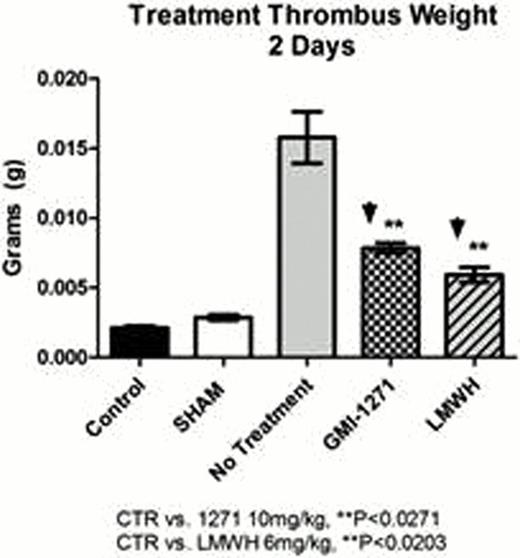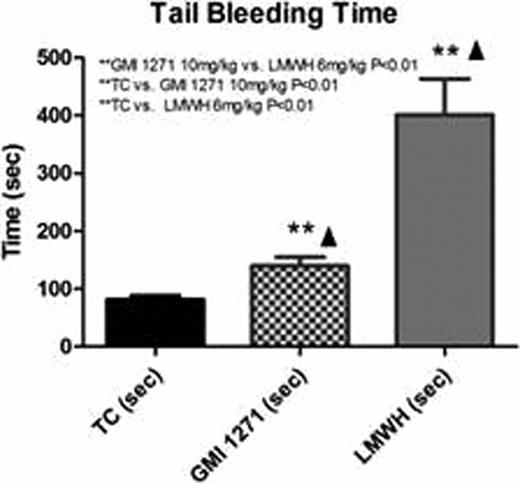Abstract
Abstract 3422
Selectins function in venous thrombosis presumably by binding and activating immune cells to initiate the coagulation cascade. E-selectin (CD62E) is known to bind and activate both monocytes and neutrophils. GMI-1271 is a small molecule antagonist that specifically inhibits E-selectin and is rationally designed to mimic the bioactive conformation of the sialyl-Lex carbohydrate ligand. Here we determine whether specific inhibition of E-selectin is sufficient to inhibit acute venous thrombosis and associated inflammatory events in both prophylactic and treatment protocols without causing the broader effects of increased bleeding time.
Male C57BL/6J mice underwent our electrolytic inferior vena cava (IVC) model to produce a non-occlusive thrombosis via electrical stimulation (250 μAmp). Animals were divided into prophylactic or treatment groups. Both groups included the following: non-thrombosed animals (TC, no surgery or drug), 2 Day sham (needle inside the IVC and no current or drug), 2 Day CTR (current and no drug), 2 Day GMI-1271 (10mg/kg IP BID), and LMWH (Lovenox®, 6mg/kg SQ QD). Animals were divided into prophylactic or treatment groups. Mice in the prophylactic group were dosed one day pre-thrombus induction through day 1. Animals in the treatment groups received the first dose of the drug following thrombus induction on day 1. Mice were euthanized 2 days post-thrombosis for tissue harvest and blood collection for the following evaluations: thrombus weight; vein wall inflammatory cell counts per high power field; vein wall-thrombus histology; and intra-thrombus polymorphonuclear cell (PMN) counts. A separate group of mice received IV administration of compounds for tail bleeding time evaluation (seconds).
GMI-1271 Significantly Decreases Venous Thrombus Weight (Figure 1).
Treatment with GMI-1271 decreased venous thrombus formation in a dose-dependent manner with significant inhibition at 10mg/kg (P=0.0271). Treatment with LMWH significantly decreased thrombus formation 2 day post induction at 6mg/kg (P=0.0203). All mice pre-treated prophylactically with GMI-1271 or LMWH followed the same pattern of decreasing thrombus weight 2 days post injury (P<0.05).
E-selectin Inhibition with GMI-1271 Does Not Increase Bleeding Potential (Figure 2)
LMWH at 6 mg/kg dose significantly elevated tail bleeding times in mice versus controls (341±27, 491±60 vs. 82±6 seconds, P<0.01). GMI-1271 (10mg/kg, IV) had significantly lower tail bleeding times compared to an IV dose of LMWH (6mg/kg, P<0.01).
Treatment: Only treatment with GMI-1271 significantly decreased vein wall monocyte extravasation compared to controls (P<0.05). Prophylaxis: GMI-1271 and LMWH prophylaxis significantly decreased vein wall PMN extravasation 2 days post thrombosis (P=0.027 and P=0.007 respectively). The same pattern held true for prophylaxis with GMI-1271 and LMWH on vein wall monocyte extravasation at the same time point (P<0.01).
Intra-Thrombus PMN Counts: GMI-1271 prophylactic therapy significantly decreases intra-thrombus cell counts versus control animal (14.5±3.7 vs. 37.4±4.7 PMNs/HPF, P=0.009), and these animals had decreased venous thrombus burden. Of interest, only mice receiving GMI-1271 therapy visually have more intra-thrombus vascular channels compared to control animals and mice receiving LMWH therapy.
GMI 1271 inhibits venous thrombosis and significantly decreases thrombus weight. GMI 1271 proposes a much lower risk of patients having bleeding complications. Vascular channels exclusively present in thrombi from mice receiving GMI-1271 therapy may aide in thrombus resolution which is currently under investigation. Delayed inflammatory cell recruitment of all cell types into the vein wall post thrombus induction indicates a possible decrease in leukocyte activation. This data suggest that inhibition of E-selectin is sufficient to inhibit venous thrombosis without an increased bleeding risk and the small molecule E-selectin specific antagonist GMI-1271 is a viable therapeutic candidate for venous thrombosis treatment and prophylaxis.
Patton:GlycoMimetics: Employment. Magnani:GlycoMimetics: Employment, Equity Ownership.
Author notes
Asterisk with author names denotes non-ASH members.



